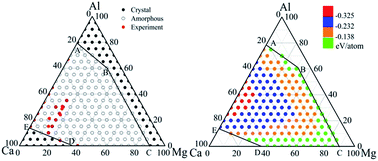Atomistic approach to design favored compositions for the ternary Al–Mg–Ca metallic glass formation
Abstract
An interatomic potential is first constructed for the Al–Mg–Ca system under the formalism of long-range smoothed second-moment approximation of tight-binding scheme, and then applied in Monte Carlo simulations to compare the relative stability of a crystalline solid solution versus its disordered counterpart using solid solution models. Simulation results not only predict a glass formation region (GFR), within which the Al–Mg–Ca metallic glass formation is energetically favoured, but also derive the amorphisation driving force (ADF), i.e., the energy difference between the solid solution and disordered state. The ADF is proposed to be positively correlated to the glass forming ability (GFA), suggesting that the larger the ADF is, the easier it is to produce the amorphous alloy and the more stable it is. Moreover, Voronoi tessellation analysis shows a distinct arrangement of Al (Mg, Ca)-centered cluster, correlating closely to the atomic radii and the formation energy of the components. The predictions are fairly consistent with the experimental results reported so far.


 Please wait while we load your content...
Please wait while we load your content...